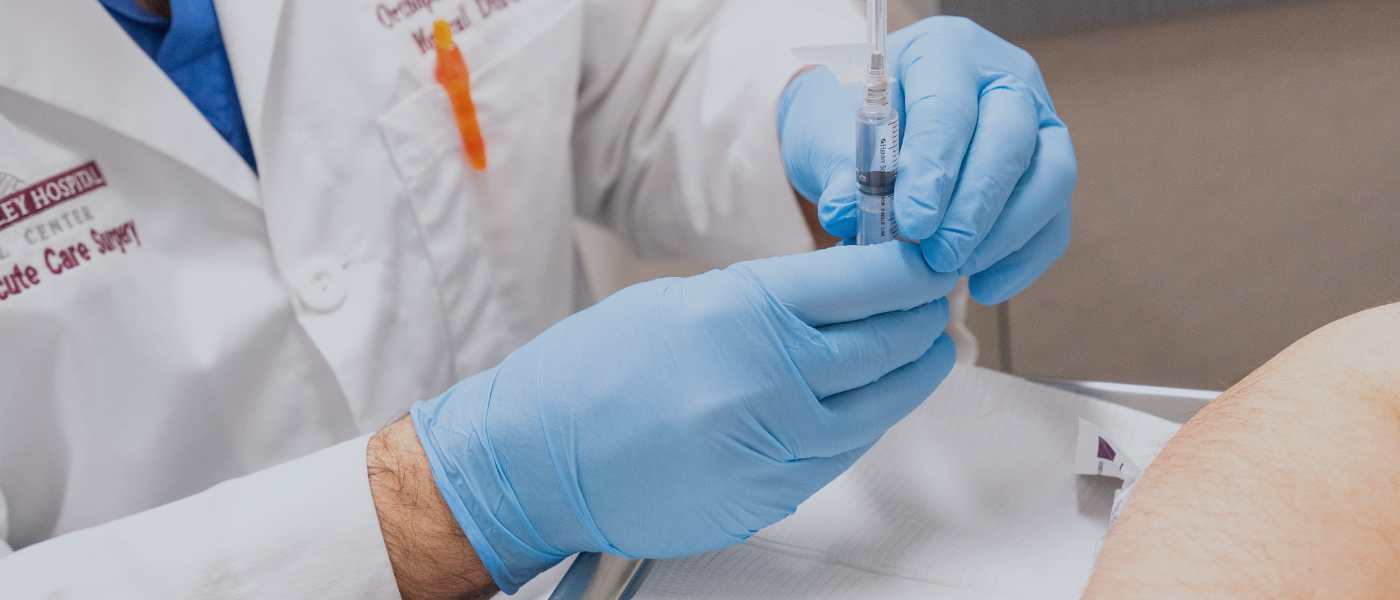
Hyaluronic Acid Injections for Joint Pain
What are hyaluronic acid injections, and what are they used for?
Hyaluronic acid injections, also called viscosupplementation, deliver HA directly into a joint to restore lubrication and cushion the cartilage. They are most commonly used for treating painful knee osteoarthritis, although they can also be used in the hips and shoulders. By boosting the concentration of HA in the joint, these injections aim to:
- Relieve pain
- Improve flexibility and range of motion
- Reduce inflammation
- Support cartilage repair and stimulate natural HA production
HA injections work differently from anti-inflammatory medications, reducing the effects of inflammation while also physically improving joint cushioning.
How are HA Injections different from other types of shots?
Unlike corticosteroid injections, which primarily reduce inflammation, HA injections work by restoring the joint’s natural lubrication and cushioning, improving the mechanics of movement. They can enhance cartilage protection, support synovial fluid viscosity, and promote a healthier joint environment, potentially slowing cartilage breakdown. This contrasts with steroid shots, which provide faster but often shorter-term relief and do not address the underlying loss of joint lubrication.
Who is a good candidate for hyaluronic acid injections?
Patients with mild to moderate knee osteoarthritis tend to benefit the most. Some patients experience relief within a few weeks, while others may notice only modest improvement. Relief typically lasts around six months, and repeated injections can extend the benefit.
HA injections can:
- Match or exceed the pain relief from NSAIDs for some patients
- Reduce stiffness and improve walking and daily movement
- Potentially delays the need for joint replacement
Factors like age, obesity, and severity of arthritis can influence effectiveness, with lower success rates reported in patients over 65 or with advanced OA. A discussion with your healthcare provider can help determine if HA injections are right for you.
How effective are they, and what are the side effects?
Some patients experience noticeable relief within a few weeks, while others see more gradual or modest improvement. HA injections can match or even surpass other nonoperative treatments, such as NSAIDs, for temporary pain relief.
Benefits typically last about six months, and repeating injections can extend relief, especially when combined with physical therapy or activity modifications. Immediate benefits may include reduced joint stiffness and swelling, while longer-term advantages can include improved mobility, delayed need for joint replacement, and enhanced cartilage support.
Most adverse reactions are mild and short-lived, such as joint pain, swelling, or redness at the injection site that usually resolves within 1-3 days. Rare but serious complications, like pseudoseptic arthritis, may occur after repeated injections and require prompt medical attention.
Overall, HA injections have a well-established safety profile, particularly when compared to long-term NSAID use.
What is the procedure like, and how long is the recovery?
HA injections are quick, outpatient procedures. The joint is cleaned and sometimes numbed, and if fluid has accumulated, it may be drained first. The injection itself takes only a few minutes. Most patients can go home immediately; however, it’s recommended to avoid heavy activity, such as jogging, lifting, or contact sports, for a few days. Improvements may take several weeks, and most people can resume regular daily activities shortly after the procedure.
Will insurance cover a hyaluronic acid injection?
Medicare and most private insurers typically cover a limited number of HA injections, though coverage rules vary. To avoid surprises, it’s best to confirm your plan details in advance. Reach out to Premier Orthopaedic & Trauma Specialists to schedule a consultation and find out if HA injections are the right option for you.











